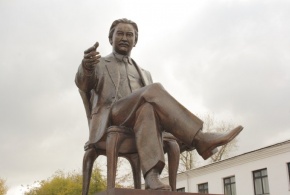
In the run-up to the Day of the First President of the Republic of Kazakhstan, the Historical and Art Exposition entitled the «Seven Facets of the Great Steppe» was opened in the library of Al-Farabi KazNU, reports press service of the university.
This exposition reflects all the seven symbols of Kazakh historical heritage, highlighted in the Elbasy's paper. The Hunnu's unique alphabet, first shown to the public in Kazakhstan, can be called sensational. It consists of 136 letters recreated by Chinese scientists based on archaeological finds from different years in Hungary, Germany, Bulgaria, China, Norway, Mongolia, and Russia.
«It should be recalled that at the first centuries of our era, the ancient history of Kazakhstan, Europe and Asia was filled with turbulent events associated with the nomadic Hun tribes that have come to us as the era of the «Great Migration of Population». However, as it was rightly noted in the article entitled the «Seven Facets of the Great Steppe», the «Eurocentric point of view did not allow to see the real fact that the Sakas, the Huns, the Proto-Turkic ethnic groups were part of the ethnogenesis of our nation» and left an outstanding cultural and historical heritage of world importance», - said scientist Gibadat Gabbasuly.
According to the scientist, the first 9 letters of the alphabet were found in Mongolia in a burial on a statuette of a Hunnic man made of pure gold. From 10 to 50 letters were written on a bronze knife belonging to the Hun, found in the area of Chyndy (China). Letters from 51 to 78 have been restored according to the inscription on a wooden box of the trilateral form, found in the Avar burial (Hungary). The letters 79 to 107 have been found on exhibits during excavations in Germany. The letters 108-125 have been found on cultural exhibits in the tombs of Avars near the ancient capital of Bulgaria. The letters 126-129 are runic signs common in Norway. The letters 130-136 have been found on exhibits in ancient tombs and in the areas inhabited by the nomadic Huns in Mongolia and Russia.
Hunnu Alphabet is officially registered in the Academy of Social Sciences of the People’s Republic of China, as evidence of the existence of a Hunnic letter. Kazakh historians, orientalists, linguists have yet to work with scientists from China and Mongolia to further explore the history and culture of the ancient Hun tribes, and their role in the development of world civilization.



















 Сот белсенді Ермек Нарымбайдың мерзімінен ерте босап шығу туралы өтінішін орындамады
Сот белсенді Ермек Нарымбайдың мерзімінен ерте босап шығу туралы өтінішін орындамады
 Poverty and misery of …. “terrorists”
Poverty and misery of …. “terrorists”
 SCIENTISTS OF THE KAZNU ARE INVESTIGATING THE PROBLEM OF SURVIVAL OF MICROORGANISMS IN EXTREME CONDITIONS
SCIENTISTS OF THE KAZNU ARE INVESTIGATING THE PROBLEM OF SURVIVAL OF MICROORGANISMS IN EXTREME CONDITIONS
 "Atomic" exam for officials of Kazakhstan
"Atomic" exam for officials of Kazakhstan
 Faculty of Journalism of the Al-Farabi Kazakh National University held an annual scientific and practical conference «Bekhozhinov readings»
Faculty of Journalism of the Al-Farabi Kazakh National University held an annual scientific and practical conference «Bekhozhinov readings»
 Kazakhstan signed an agreement with Russia on the allocation of vaccine against coronavirus
Kazakhstan signed an agreement with Russia on the allocation of vaccine against coronavirus